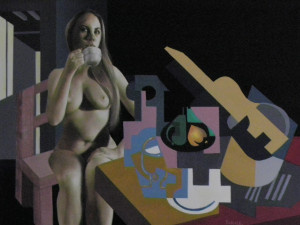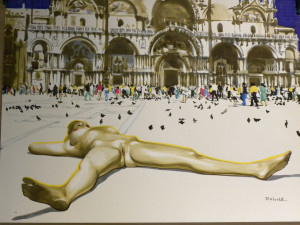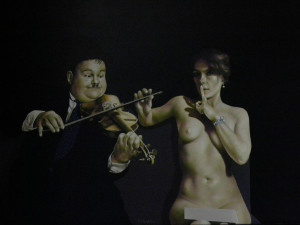Roland Delcol
Roland Delcol
Blog
Intellectual Riddle from Roland Delcol
Ajouté le 20 mars 2018
Intellectual Riddle from Roland Delcol
Each of his pictures is a rebus composed of images, an intellectual riddle that sometimes is unintelligible, and sometimes not so.
Roland Delcol was born in 1942 in Brussels. In the years 1960-1963. Studied at the Brussels Free University, then in 1963-1971. At the St. Sainte-Gilles Academy of Arts. The artist has many personal exhibitions in Belgium, France, Italy, Israel, Germany and the United States.
His work brought him international fame and recognition. Delkol’s canvases surprisingly make it possible to see how interesting the result is when the artist’s creative biography combines two factors: classical art education of the highest level and a deep understanding of historical processes, philosophy, sociology, and art history.
Behind the word “hyperrealism” in the case of Del’kol, the curious content is hidden: at one time the artist managed to find his own niche in contemporary art – and this niche has become in some way his brand. It’s enough to take one look at any picture of a Belgian to make sure: Roland Delcol is writing in a classical style and if desired he could become an outstanding realist. However, realism as such does not interest him. Another thing is hyperrealism, … by the definition of the philosopher Baudrillard, “the simulation of something that never really existed.” Let’s say a simulation of a meeting between Pinocchio and Venus, or simulation of a meeting of a nude beauty with the mother of the artist James Whistler, or simulating a meeting of actor Humphrey Bogart with a nude woman again in the restaurant amid a mysterious faceless subject wearing a hat that clearly follows the characters.
Art is always an art – and all the characters of Del’col, from cartoons to cult artists, would find a common language with naked women, why not find a common language with one beauty with another beauty … And this is not at all erotomania: Delcolus wrote his heroines with Wife and daughter. Perhaps nudity symbolizes for him the consumer society, the art of kitsch and other delights of the present. But that’s not all: according to Delkol himself, each of his pictures is a rebus composed of images, an intellectual riddle that sometimes is unintelligible, and sometimes not very (by the way, none of the pictures has a name to make it easier for us Task). Hyperrealistic paintings somehow provoke reflection.
“Everything is contained in everything, everything depends on everything, the chain of causes and effects is infinite, and it is accompanied only by stops and transplants.” What obviously can never be decisive, the first thing that caught sight is not the last. ” Roland Delcol
USA Art News.com, Events and Trends of the United States Art and Culture,"Intellectual Riddle from Roland Delcol", Helen July 2017.
50nuancesdecourbet / Grand Écart. Bruno Picard.
Ajouté le 20 mars 2018
Il y a tout un peuple qui trotte dans la tête de Roland Delcol : des icônes hollywoodiennes, acteurs ou réalisateurs, des écrivains et des poètes, des peintres et des sujets de peintres, des personnages de dessins animés, et des femmes. Nues les femmes, toujours ; du moins, toujours des femmes nues.
Il y a tout un tas de femmes nues qui trottent dans la tête de Roland Delcol. L'obsession de la femme nue n'est pas l'apanage des peintres, certes : mais, contrairement au commun des mâles, avec eux, ça se voit. Parce que les femmes nues, dans la tête de Delcol, leur puissance érotique est trop forte pour être contenue ; alors Delcol les extrait de sa tête et les peint. Le corps nu, hyperréaliste, dont la clarté de la chair brille comme un astre dans l'obscurité d'un fond le plus souvent noir, qui lui renforce sa puissance d'attractivité. « Il faut de la vaillance pour, malgré des morales et forçant sur la mode, faire luire ce qu'il y a de plus beau sur terre comme une étoile parmi les lumières de la rue, comme une opaline dans l'ombre d'une chambre, pour fondre corps et vérité » [2] : c'est son ami écrivain surréaliste belge Louis Scutenaire qui le dit dans La Chanson de Roland, poème épique qu'il lui a dédié. Emile Zola -qui n'était ni surréaliste ni ami du peintre- disait que Courbet était un "faiseur de chair" [3]. Delcol, lui, peint la chair de la femme comme on polit une pierre... avec lui, on rentre dans l'âge de la femme polie.
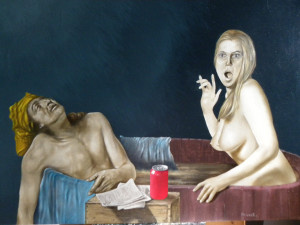
Il y a tout un tas de femmes nues qui trottent dans la tête de Roland Delcol, et leurs appâts physiques - le cheveu blond, les seins lourds, la toison fournie, le cul sublime - font assaut du regard aussi sûrement que dans Le Viol de Magritte. Mais, comme « le pêché n'existe que dans les yeux du voyeur » [4], les femmes de Delcol n'ont jamais d'intentions exhibitionnistes. Assises, debout, couchées, leurs nudités sont saisies dans des poses qui se veulent naturelles, rarement provocatrices, jamais sciemment perverses. Fausses ingénues, on dirait qu'elles ignorent le caractère lascif de leur corps, et leur sensualité n'en est que mieux renforcée.
Il y a tout un tas de femmes nues qui trottent dans la tête de Roland Delcol, mais elles sont rarement seules. Autour du corps nu, un contexte improbable multi-référencé, jouant avec humour souvent sur l'intemporalité. Un mélange qui détonne, comme des chocs visuels. Des toiles toujours intitulées Sans paroles au pluriel, comme si, en ne parlant pas, elles avaient beaucoup à dire... Dans un jeu d’anachronisme, Roland Delcol marie ses modèles contemporains à des icônes passées, des Prévert, Picasso, Hitchcock, Laurel et Hardy... ou à des références de l'art classique, Olympia de Manet, en Vénus de Titien, aux côtés de la Joconde, de Marat dans sa baignoire, de la Femme en bleue lisant une lettre de Vermeer. Par ces associations libertaires, le peintre abolit les hiérarchies picturales et confronte non sans humour les chefs d’œuvres de l'histoire des arts aux sujets contemporains. « Est-ce que La Joconde est plus importante que le portrait de Laurel et Hardy, je vous le demande... » [5]. Il donne une appellation à ce courant de peinture : post-modernisme.
Des femmes nues, dans sa tête, Courbet devait en avoir aussi quelques-unes -l'obsession de la femme nue n'étant pas une spécialité belge -nationalité de Delcol- : pas de jeu d'anachronisme, pour lui, ses modèles sont toujours saisies dans leur contemporanéité. Pas de référence extérieure à son univers érotique. Les femmes de Courbet ne sont pas ingénues, elles connaissent la charge érotique qui émane de leurs nudités. Elles l'assument. Comme est assumée toute une imagerie de bordel plus ou moins pornographique, des Belloc ou autres Moulin, qui hantait son atelier. Assurément, le peintre d'Ornans avait tout un peuple nu qui trottait dans sa tête. Faire le compte de ses maîtresses tient de la gageure, même s'il s'en targue souvent dans son abondante correspondance. « Comme beaucoup d'artistes de son époque, il papillonnait de modèles en grisettes, sans se fixer vraiment, sans se fixer surtout » [6].
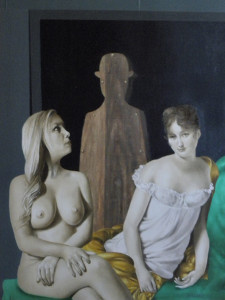
L'hommage de Delcol à Courbet pourrait ainsi être interprété comme une reconnaissance d'obsession partagée -toute admiration gardée, car il y a obsession bien plus nuisible ! Il est étrangement cadré, cet hommage, ainsi perché dans un angle. La radio avait son Oreille en coin ; avec Delcol, la peinture a sa vulve en coin. Elle a la pilosité électrique et la fente halitueuse. Elle est surtout largement ouverte grâce à un grand écart magistral. Ses cuisses semblent battre comme des ailes. C'est sans doute pour cela que cette Origine est ainsi placée : c'est qu'elle est en plein envol. Elle domine le monde comme un oiseau ; elle pourrait nous jeter un raie de pisse ou une fiente au visage. Là-haut, la femme est en position de force. Elle rayonne comme un astre ; elle rayonne par son astre sexué. Elle rayonne sur l'esprit du peintre, l'éblouit au point de rendre vacuité tout ce qui l'entoure, en somme elle le soumet à sa présence. Ce fond blanc, c'est la tête du peintre, celle du regardeur, celle de l'homme hétérosexuel en général, un vide dominé par cette présence obsédante de fente poilue qui s'ouvre à la conscience avec la récurrence d'un battement d'ailes. Cette Origine du monde belge n'est pas un sexe : c'est une allégorie de l'obsession de l'homme pour la femme (nue de préférence), et surtout pour son sexe -le reste peut bien disparaître !
Le reste, ce sont les querelles de clochers, toutes les luttes de chapelles artistiques dont les identités s'incarnent dans leur -isme de terminaison. Courbet voulait s'affranchir du classicisme, de l'académisme, tout autant que du romantisme, et de sa branche orientaliste. Il est à l'origine du réalisme en peinture, quand il écrit, en 1855, dans la brochure accompagnant son exposition personnelle réalisée en marge du Salon officiel : "Le titre de réaliste m'a été imposé comme on a imposé aux hommes de 1830 le titre de romantiques. Les titres en aucun temps n'ont donné une idée juste de choses : s'il en était autrement les œuvres seraient superflues" [7]. Dans les années 1960, dans la mouvance du pop art, naît un courant artistique dont la vocation est le rendu minutieux de l'image au point d'être confondu avec la photographie ; la critique hésita longtemps : néo-réalisme, super-réalisme, photo-réalisme, l'étiquette qu'on lui accola finalement fut hyperréalisme. Dans cette case fut placé Delcol. Courbet, le réaliste, cherchait moins à rendre réelle -quasi photographique- l'image même (les peintres pompiers s'y employaient avec talent) qu'à décrire le réel de son temps ; inversement, l'hyperréalisme s'attache moins au réalisme du sujet qu'à celui de l'image. De fait, les toiles de Delcol sont souvent surréalistes... mais, bigre ! Il faut être clair sur sa religion ! En somme, point de consensus possible. La guerre des -ismes peut se poursuivre (c'est d'ailleurs sans doute tout l'intérêt de cette catégorisation orchestrée plus par la critique que les peintres eux-mêmes). Aucun consensus...
La version de Delcol fait partie d'une série de douze lithographies intitulées Ankle Strap's accompagnant une version "luxe" du roman érotique Emmanuelle, dont l'adaptation du premier opus était sortie l'année précédente au cinéma avec le succès que l'on sait. C'est naturellement vers Roland Delcol et son univers d'érotisme surréaliste que l'éditeur Tchou s'est tourné pour l'illustration. Cette Origine du monde n'est donc pas une oeuvre directement en rapport avec celle de Courbet, mais c'est néanmoins sous ce titre qu'elle est présentée en 2015 à l'Université du Kent dans une exposition intitulée Beautifully Obscene. Aussi le peintre ne voit-il pas d'objection à reconnaître a posteriori sa version comme hommage à Courbet.
Roland Delcol a forcément quelque chose à voir avec Courbet. S'il l'on pouvait les faire échanger, ils parleraient sans doute d'art avec passion, réalisme et hyperréalisme (ou "sur", ou "para", ou "néo" – réalisme). Certes, mais au-delà de soliloquer sur les multiples chapelles du réalisme, ils parleraient aussi politique, ces deux doux anarchisant qui voulaient chacun faire voler en éclat l'ordre moralisateur de la bourgeoisie. Mais surtout, surtout, c'est sûr, ils disserteraient passionnément sur... la femme (à poil, de préférence).
1 - Roland Delcol, Exposition au musée d'Ixelles, Bruxelles, 2012
2 - Louis Scutenaire, La Chanson de Roland, éditions L'Envers sauvage du Réèl, 1982, p.18
3 - Emile Zola, Mes Haines, Paris, 1866
4 - Louis Scutenaire, op cit, p. 20
5 - Roland Delcol, Le postmodernisme, une merveille de Roland Delcol, vidéo
6 – Thierry Savatier, L'Origine du monde, Histoire d'un tableau de Gustave Courbet, Bartillat, 4è Editions, 2009, p.55
7 - Gustave Courbet, Catalogue de son exposition personnelle, 1855
Bruno Picard, 03/02/2018
https://www.50nuancesdecourbet.com/gustave-courbet
"Sans Paroles"
Ajouté le 20 mars 2018
Collections du musée des Beaux-Arts de Liège, 2017.
Biographie de Roland Delcol
Ajouté le 29 mars 2017
E-mail address: rolanddelcol@yahoo.fr
Website: www.roland-delcol.com
fr.wikipedia.org/wiki/Roland_Delcol
Roland Delcol was born on January 24th 1942 in Brussels in Belgium.
Education:
Study at upper secondary school, Latin-Math, Saint-Gilles at Brussels 1954-1960
Study at the “Solvay Business School”, University of Brussels, Belgium 1960-1963
Theatre sets and costumes, Ministry of Culture. 1967-1968
Study at the academy of fine arts, Saint-Gilles, Brussels 1965-1971
Study lithography at “Il Trifoglio” in Milano, Italy 1970
Study lithography at the “Atelier Jobin” in Paris. 1975
Study faïence at “Moustier-Sainte-Marie” France. 1978
Study porcelain at “Florence” Italy. 1983
Honours and citation:
Government Great Silver Medalled the Academy of fine Arts 1971
Saint-Gilles painting price 1972
Short listed for Bollinger price. 1972
Distinction: “The prize of the young painting” in Belgium 1973
“Award First Place” at A Hunger Artist Gallery, Albuquerque NM. 2001
Juror Award “Sun Bowl Art Exhibit”, International Museum of Art El Paso, USA 2002
Past President Award Nothern California arts Inc, USA 2003
One-man-shows:
1965
Gallery “L’Escalier” Brussels, Belgium
1967
Gallery “La Grande Jatte” Brussels, Belgium
1969
Gallery “Isy Brachot”
Foreword of Jaques Collard and M.and G.Piqueray Brussels, Belgium
1970
Gallery “Isy Brachot”, Foreword of Louis Scutenaire Brussels, Belgium
Gallery “Schubert “ Milan, Italy
1971
Gallerry “Isy Brachot”, Foreword of Feelix Labisse Brussels, Belgium
Gallerry «Il Fauno », Foreword of Janus Milan, Italy
1972
Gallery “Isy Brachot” Knokke-Le Zoute, Belgium
Gallery “Isy Brachot”, Foreword of Louis Scutenaire Brussels, Belgium
1973
Gallery “Of the 20 Century” Charleroi, Belgium
1974
Gallery “Art Gallery, Place Beauvau” Paris, France
Gallery “Isy Brachot” Knokke-Le-Zoute, Belgium
Gallery “Artides , published Multiples” Brussels, Belgium
1975
Gallery “Debel”,
Under the patronage of the Consul General of Belgium Ein Kerem- Jerusal, Israel
Gallery “Isy Brachot” Brussels, Belgium
Gallery “The Gallery”,
Illustrations lithography’s Emmanuel, the book Knokke-Le-Zoute, Belgium
1976
Gallery “The Art Salon “Lithographs” Brussels, Belgium
Botanical Theatre,
“Integration of an one-man show of Roland Delcol in the play of Richard Olivier, “King Singer” Brussels, Belgium
1977
Gallery “Isy Brachot”, Foreword of Florent Bex Brussels, Belgium Gallery “The Ary Salon” Brussels, Belgium
1978
Gallery “Crals” Liege, Belgium
“Brussels Jazz Club” integration of paintings in the club Brussels, Belgium
“J.M.V.Fine Studio” exhibition of glazed earthenware Moustiers-Ste-Marie, France
1979
Gallery “Kamp” paintings Amsterdam, Netherlands
“J.M.V.Fine Studio” exhibition of glazed earthenware Moustiers-Ste-Marie, France
1980
“J.M.V. Fine Gallery” exhibition of glazed earthenware Moustiers-Ste-Marie, France
1981
”J.M.V. Fine Studio” exhibition of glazed earthenware Moustiers-Ste-Marie, France
“The Freesbe” integration of paintings in the club Brussels, Belgium
1982
“Horta Museum” ten years of lithographs
Presentation of the book”La Chanson de Roland” by Louis Scutenaire Brussels, Belgium
1983
Gallery “Angoletto” Florence, Italy
1984
Gallery “Angoletto” Florence, Italy
1993
Gallery “Espace Deauville” during the “American Cinema Festival” Deauville, France
2000
Gallery “Alexie”, Brodway New-York, USA
2005
Gallery “Sarrat” Vanderbilt University Nashville, USA 2008
Museum “Wiesbaden” Wiesbaden, Germany
2011
Gallery “Espace Lorraine” Brussels, Belgium
2012
“Ixelles Museum” Brussels, Belgium
2013
“Parliament of Belgium” Brussels, Belgium
2014
City Hall of Saint-Gilles,
“A discreet tribute to Irène to hamoir” by Roland Delcol Brussels, Belgium
Gallery “Emilie Dujat”, “L’ordre Nu” Brussels, Belgium 2015
Gallery“St-Lucas“ Tallin, Estonia
“Must art” Gallery Moscow, Russia
Collective Shows:
1971
Gallery “Isy Brachot” Knokke-le-Zoute, Belgium Gallery “Isy Brachot” Brussels, Belgium
1972
Gallery “Isy Brachot” Brussels, Belgium Gallery “Isy Brachot” Knokke-le-Zoute, Belgium
“Convention Center”, “The Painters of Brabant” Brussels, Belgium “Bollinger Prize” Brussels, Belgium
1973
Gallery “Isy Brachot” Brussels, Belgium
“Art 4’73”, Contemporary Air Fair Bale, Switzerland
“IKI 73”, Contemporary Air Fair Dusseldorf, Germany
Gallery “Nick Treadwell”, Christmas Exhibition London, England
1974
Gallery “Isy Brachot”, “American and European Hyperrealism” Brussels, Belgium
“First Contemporary Art Salon” Brussels, Belgium
Gallery “Espace 2000”, Contemporary Visionaries, Brussels, Belgium
(Adami-Ayo-Erro-Monory-Fromanger-Klasen-Recalcati-Ranciac-Roux-Delcol-Sämpfly)
“Center for Fine Arts”, exhibition devoted to “Young Belgian Painting Brussels, Belgium
“ANHYP” Art Center, Belgian Artist Brussels, Belgium
“Art 5’74” Comp temporary Air Fair Bale, Switzerland
International Art market 74, “One Man show” Cologne, Germany
Gallery “Nick Treadwell”, “Mona Lisa 74” exhibition London, England
“IKI 74” Contemporary Air Fair Dusseldorf, Germany
Gallery “Château Malou”, “Operation 500-5000” Lithographs Brussels, Belgium
Gallery “Artides, published Lithographs” Brussels, Belgium
1975
Gallery “Isy Brachot” Knokke-le-Zoute, Belgium
Gallery “Château Malou”, “Truc Troc” Brussels, Belgium
New engraving lithograph Paris, France
“5 Gallery”, lithograph Paris, France
Gallery “Ange”, lithograph Paris, France “SIGMA 13”, “Hyper and Realism in Belgium”,
in cooperation with the Ministry of French Culture Tournai, Belgium
1976
Gallery “Grands Augustins”, drawings Paris, France
“Center for Fine Arts”, “Kunsthalle”, “Schuh Werke” fair of art Nuremberg, Germany
Fair of Art, “FIAC 1976” Paris, France
“Published by La Tortue”
Gallery “Isy Brachot” Brussels, Belgium
Gallery “Château Malou”, “Truc Troc” Brussels, Belgium
1977
Gallery “Daniel”, under the patronage of Ambassador of Belgium Mexico, Mexico
“Salon de Mai”, in Paris Paris, France
“Salon of Today’s Great and Young Paris, France
Gallery “Nick Treadwell”, “Romance return, everything’s forgiven” exhibition London, England
1978
“American Center” Paris, France
“Salon de Mai”, in Paris Paris, France
“Salon of Today’s Great and Young Paris, France
“Belgian hyper and realists 1978”, Luxembourg, Luxembourg
Gallery “The Art Salon “, “Amnesty International”
Arman-Botero-Calder-Delcol-Dibbets-Folon-Hockney-Miro-Topor… Brussels, Belgium
1979
“UNESCO” Paris, France
Salon in Ranelagh, « Cristal Figuration » Paris, France
“Salon of Today’s Great and Young Paris, France
“Salon of Young Painters”, Chapiteau Monparnasse Paris, France
Free University of Brussels, “Figurative Painters with Ideas” Brussels, Belgium
“Drouot Orsay Hotel”, “French Association against the Death Penalty” Paris, France
1980
Free University of Brussels, “Behind reality” Brussels, Belgium
1984
Gallery “French” Munich, Germany
1996
Brussels Royal Museum of Modern Art, “What is attractive is beautiful”
“Iréne, Scut, Magritte and Co” Brussels, Belgium
1997
Ludwig Forum für Internationale Kunst Aachen, Germany
1998
Von der Heydt-Museum, Kunsthalle Barnem Wuppertal, Germany
Gallery “Städtische” Albstadt, Germany
Kunstmuseum Thun, Germany
Gallery “Städtische” Regensburg, Germany
1999
Gallery “Städtische Jesuitenkirche” Aschaffenburg, Germany Gallery “Städtische Delmenhorst” Haus, Coburg, Germany
2000
Gallery “Caplain-Matignon” Paris, France
2001
A Hunger Artist Gallery Albuquerque, New Mexico, USA
Gallery “Kingston” Boston, USA
Gallery “Caplain-Matignon” Paris, France
2002
Suermondt-Ludwig Museum, “Melancolie und Eros” Aachen, Germany
Gallery “Städtische Paderborn”,
“The female Nude in the 20th Century” Westphalia, Germany
Allentown Art Museum Pennsylvania, USA
“www.postpicasso.com”, exhibition on line Richmond, USA
Anguilla International Arts Festival, Third Biennial event Anguilla, British West Indies
International Museum of Art, “Sun Bowl Art Exhibit”,
Winner of the “Juror Award” El Paso, Texas, USA
Gallery “Brad Cooper”, “Nude in the Post Modern” Tampa, Florida, USA
Laredo Center for Arts, “Tenth International Juried Competition” Pennsylvania, USA
2003
Westmoreland Arts and Heritage Festivals, “Nationals Juried Exhibition”,
And at the Westmoreland County Community College Latrobe, Pennsylvania, USA
“www.postpicasso.com”, “Digesting Consumerism” exhibition on line Richmond, USA
Northern California Arts, Inc,
48th International Open Exhibition, “Bold Expressions” Carmichael, California, USA
Gallery “Städtische Neue”, “Romantic in the 20th Century” Dilligen an der Donau, Germany
International Museum of Art, “Sun Bowl Art Exhibit 2003” El Paso, Texas, USA
Selected in “Stock Images Catalogue Volume one”,
And “Refocus Now”, www.refocus-now.co.uk London, England
2004
Associated Artists, “Dimensions 2004” Winston-Salem, USA
Gallery “Art@Large“, “Neo Erotique” 2th annual Juried Show New-York, USA
Gallery “Fraser”, 2004 Georgetown International Art Exhibition Washington, D.C., USA
Gallery “Brad Cooper”, 2004 Biennial event Tampa, Florida, USA
Anguilla International Arts Festival, Fourth Biennial event Anguilla, British West Indies
2006
Gallery “Brad Cooper”, “Landscape in Post-Modern” Tampa, Florida, USA
Gallery “Fraser”, International Fine Art Exhibition 2006 Bethesda M.D., USA
2007
The Art Center Gallery, Clatstop Community College
“Au Naturel”, The Nude in the 21th Century Oregon, USA
South Texas College, “2007 Human Rights Exhibition” Mac Allen, Texas, USA
2008
The Art Center Gallery, Clatstop Community College
“Au Naturel”, The Nude in the 21th Century Oregon, USA
Westmoreland Arts Nationals Latrobe, Pennsylvania, USA
2008-2009
Museum Kunst Palast, “Aktaïon und Diana” Dusseldorf, Germany
2009-2010
Siegerland Museum,”Phantastische Welten” Siegen, Germany
Kunstverein,”Phantastische Welten” Gutersloh, Germany
2010
Museum Moderner Kunst Wörlen,”Phantastische Welten” Passau, Germany
Museum Der Stadt Ratingen,”Phantastische Welten” Ratingen, Germany
Westmoreland County Community College,
“Westmoreland Arts Nationals”
"Beautifully Obscene: The History of the Erotic Print", University of Kent, Studio 3 Gallery.
Ajouté le 7 juin 2015

"Featuring over 50 works from across Europe and Japan and Spanning the course of 500 years, Beautifully Obscene incorporates the different approaches used by artists in order to explore themes of sexuality, gender roles and power.
The artists whose works will be exhibited are: Pietro Aquila, Pietro Santi Bartoli, Monika Beisner, Jan de Bisschop, Emma Bradford, Simone Cantarini, Stephen Chambers, Marianne Clouzot, Gabriel Dauchot, Angele Delasalle, Roland Delcol ,Amandine Dore, Tracey Emin, Brad Faine, Henri Fantin-Latour, Valentin Le Fevre, Ian Hamilton Finlay, Othon Friesz, Frans de Geetre, Paul Guiramand, Sarah Hardacre, William Hogarth, Katsushika Hokusai, Anita Klein, Rudolf Koch, Antonio Lafrery, Martin Van Maele , Albert Marquet, Henri Matisse, Patricia Nik-Dad, Pablo Picasso, André Provot, Felicien Rops, Berthommé de Saint-André, Kitagawa Utamaro, Alex Varenne, Marcel Vertes , Denis Volx, Lucas Vorsterman, and Shane Wheatcroft." By Gary Hughes, 16 April 2015

Roland Delcol
The Ankle Strap is part of a series of twelve lithographs by Belgian hyper-realist Roland Delcol. Born in 1942, Delcol studied at the Académie des Beaux –Arts de Saint-Gilles from 1965 to 1971 after three years at the University of Brussels. During his time at art school, he studied lithography in Milan before returning to this technique at Paris’Atelier Jobin in 1975, the year that the Ankle Strap was printed. Whilst photo-realist in style, this print is rooted in the surrealist tradition of the artists who influenced him: René Magritte (1898-1967) and Paul Delvaux (1897-1994). Delcol’s depiction of the female body, however, moves beyond the work of these artists in furthering surrealist eroticism and using a postmodern approach.
The Ankle Strap’s series of lithographs were intended to accompany the erotic novel Emmanuelle by Emmanuelle Arsan which explores the love/lust dualism by contrasting a woman’s series of anonymous erotic encounters with her desire for love in her sexual relationships. The print’s relationship to an erotic novel is not unprecedented in surrealism: Salvador Dali made a series of prints to accompany Leopold von Sacher-Masoch’s sadomasochistic novella “Venus in Furs” and Pauline Réage’erotic “Story of O” inspired prints by Leonor Fini.1 Indeed as explored by Neil Philip earlier in the publication, many Surrealist artists created works immersed in sexual themes.
Delcol heightens the eroticism in his print by itemising parts of the female body whilst working in a realist style. Much of The Ankle Strap has been left unprinted or shaded in very light tones, heightening the impact of the solid black of the shoe strap and the pubic hair as focal points of the image. Highlighted is the play on the traditional connotations of a woman revealing her ankle, a suggestion not only referenced but turned upside-down as the woman’s ankles are only clothed part of her body. The second highlight, the woman’s genitalia, works alongside the photo-realism to suggest an explicit depiction of a woman more life-like than the sketchy nudes of Dali and Fini. By removing the woman’s head from the picture, Delcol follows “the precedent of surrealist paintings of women cut up or disassembled”.2 Robin Adèle Greeley argues that in works like “Le Viol” (1935), which depicts a woman’s eyes and mouth replaced with her breasts and genitals, Magritte depicts the woman’s speech as competing with her sexuality.3 This tradition extends from Gustave Courbet’s “L’origine du monde” (1866) and Marcel Duchmp’s “Etant donnés”1, “La chute d’eau”2, “Le gaz d’eclairage” (1946-66) where woman are show only through the depiction of their genitalia. These fetishist images also relate to the French blazon tradition where only part of the subject is revealed. Delcol’s cropping of the image silences his subject, replacing her words and identity with an eroticism both explicit and suggested.
The Ankle Strap’s anonymity and relationship to an erotic novel develops Delcol’s work beyond surrealism not only in terms of eroticism but also in the context of Michel Foucault’s essay “Ceci n’est pas une pipe”4. Writing about Magritte’s painting “The treachery of Images” (1928-9) that depicts a pipe with the latter phrase below it, Foucault distinguishes the concept of “resemblance”, when a signifier imitates a primary referent, and “similitude’, when the referent of the signifier is itself another signifier leading to a chain of displaced meaning. Foucault argues for similitude being characteristic of Magritte’s work and exemplified in “The Treachery of Images”. Delcol, however, exaggerates this beyond that Magritte.
Firstly, Delcol’s unbound lithographs are presented separately from the novel’s text, removing any clear connection between the prints and the passages of the text they might illustrate. The lithographs allude to the text but what they signify is unclear. As the text itself is a signifier to ideas, concepts and characters, relationship of The Ankle Strap to a work of literature sets Delcol’s prints in a chain of signifiers, the end of which we are prevented from reaching. Secondly, Delcol’s prints in a chain of signifiers, the end of which we are prevented from reaching. Secondly, Delcol’s photo-realism increases the length of this chain of referents. Delcol’s lithographs are not invisible; the images are so close to being photographic that the large spaces of unmarked paper and the texture of the paper betrayed by the moments where the black ink is disturbed, strike us with an awareness that the image is based on a photograph but is not one.5 This photograph adds an additional signifier to the chain, distancing us from this woman whose identity, as we have seen, has been cropped out of the image, ending this chain of reference in mystery.
Under Surrealism’s influence, Delcol’s prints accompanies an erotic novel and depicts an anonymous woman whose identity has been replaced by her sexuality. The photo-realism in his work builds on these surrealist foundations, making the work more explicitly erotic, and further distancing us from the ultimate reference and meaning of the work. Delcol exaggerates the distance between our understanding of this woman as a sexual being and as a person, and we find ourselves, like Emmanuelle, with love both separated from lust and out of reach.
By Georgia Kelly.
Refernces
Vincent Gille, “Love of Books, Love Books”, in Surrealism: Desire Unbound, ed. By Jennifer Mundy (London: Tate Publishing, 2002), pp.125-35.Robin Adèle Greeley, “ Image” Texts and Female Body: René Magritte and the Surrealist Publication”, Oxford Art Journal, 15.2 (1992), 48-57 (p.49). Ibid, p.50.Michel Foucault, “Ceci n’est pas une pipe”, trans. Richars Homard, MIT Press, 1 (1976), 6-21.A reference to Roland Barthes, « characterisation of the Photograph as invisible as we look past it to the image it shows”, ( Roland Barthes, “Camera Lucida": Reflections on Photography (London, 1933).
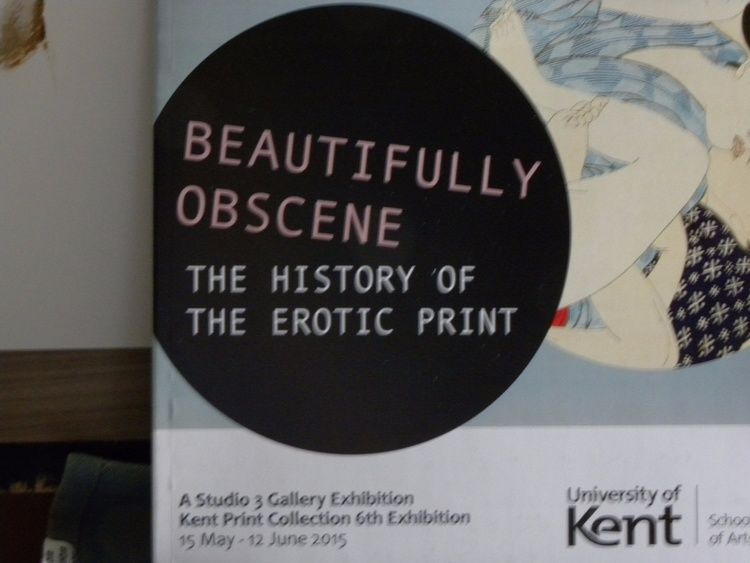
Texte d'Irène Hamoir:Roland Delcol précurseur du Postmodernisme
Ajouté le 7 juin 2015
Il s’intéresse par-dessus tout à la peinture.
De plus il sait peindre.
Sur ses toiles, insoucieux du temps et de l’espace, il provoque des rencontres de personnages, de femmes surtout, de cette époque-ci avec d’autres de ces époques-là ; les paysages et les choses se télescopent ; ses couleurs le plus souvent sont roboratives ; cela dans une mise en page qui, malgré les années qui passent et passent, ne perd rien de son poids.
Son ambition-non méprisable- est que l’unique objet de sa passion soit perçu par les meilleurs comme une œuvre de prix.
Il est transparent.
Derrière Roland Delcol il n’y a que le peintre Delcol.R..

Roland Delcol et le Postmodernisme.
Ajouté le 3 juil. 2013
"Einer der eigenwilligsten Vertreter zwischen Hyperrealismus und dem heutigen postmodernen Pluralismus ist Roland Delcol. Er wurde 1942 in Brüssel geboren und hat dort nach dem Abitur bis 1971 ein sechsjähriges Studium an der Kunstakademie absolviert. Seit 1969 trat er in Belgien und Frankreich in zahlreichen Ausstellungen mit realistischen Bildnissen unbekleideter Frauen in die Öffentlichkeit, die ihn bald international bekannt machten. Die avantgardistische Galerie Isy Brachot mit Filialen in Paris und Brüssel, in der Delcol schon als akademischer Meisterschüler erstmals ausgestellt hatte, widmete ihm 1975 eine große Übersichts-Ausstellung, begleitet von einem eindrucksvollen Katalog." Dieser Artikel kommt von Dr. Schilke Medizinischer Verlag,Von Prof. Dr. med. Axel Hinrich Murken.
"L'un des représentants les plus originaux entre l'hyperréalisme et le pluralisme postmoderniste d'aujourd'hui est Roland Delcol".(Axel Murken). Dans sa peinture l'avenir de l'art dépend du passé de l'art. Il met des œuvres intemporelles en connexion avec son propre univers.
Selon Delcol, "L’acte de peindre s’accomplit dans son œuvre pour qu’apparaisse une poésie permanente au travers de scènes mimant une réalité soi-disant banale et quotidienne. Comme l’art à une histoire, je peins des liens de filiations, et des citations puisées dans l’héritage des grands artistes d’un passé proche ou lointain. Ainsi je transmets la peinture occidentale et définis le « Postmodernisme ». C’est une rupture avec l’art dit moderne, et un abandon de la hiérarchie des styles conventionnels. Avec le rêve et la réalité confondus, par le truchement du spectateur et de son libre arbitre, une narration sort de chacune de mes toiles. Ainsi le « Postmodernisme » par son intemporalité dépasse le temps des modes."écrit Au début des années 1980 Irène Hamoir, écrivaine et épouse de L. Scutenaire avait déjà saisi le postmodernisme de la peinture de Delcol, « Il s’intéresse par-dessus tout à la peinture. De plus il sait peindre. Sur ses toiles, insoucieux du temps et de l’espace, il provoque des rencontres de personnages, de femmes surtout, de cette époque-ci avec d’autres de ces époques-là ; les paysages et les choses se télescopent ; ses couleurs le plus souvent sont roboratives ; cela dans une mise en page qui, malgré les années qui passent et passent, ne perd rien de son poids. Son ambition-non méprisable- est que l’unique objet de sa passion soit perçu par les meilleurs comme une œuvre de prix. Il est transparent. Derrière Roland Delcol il n’y a que le peintre Delcol.R. »

